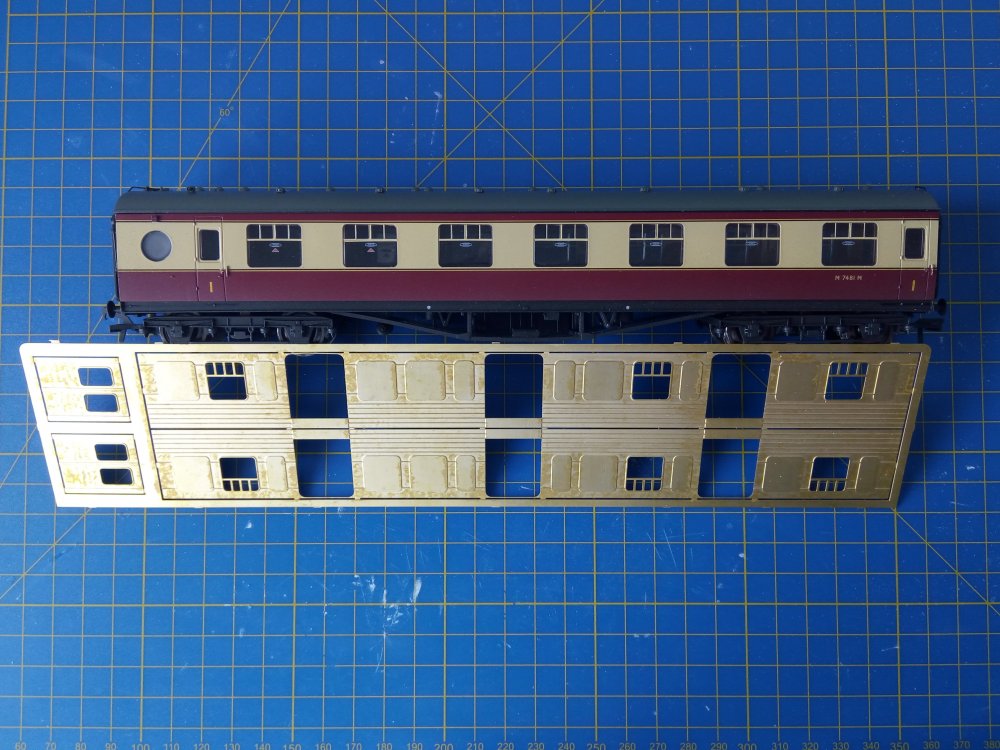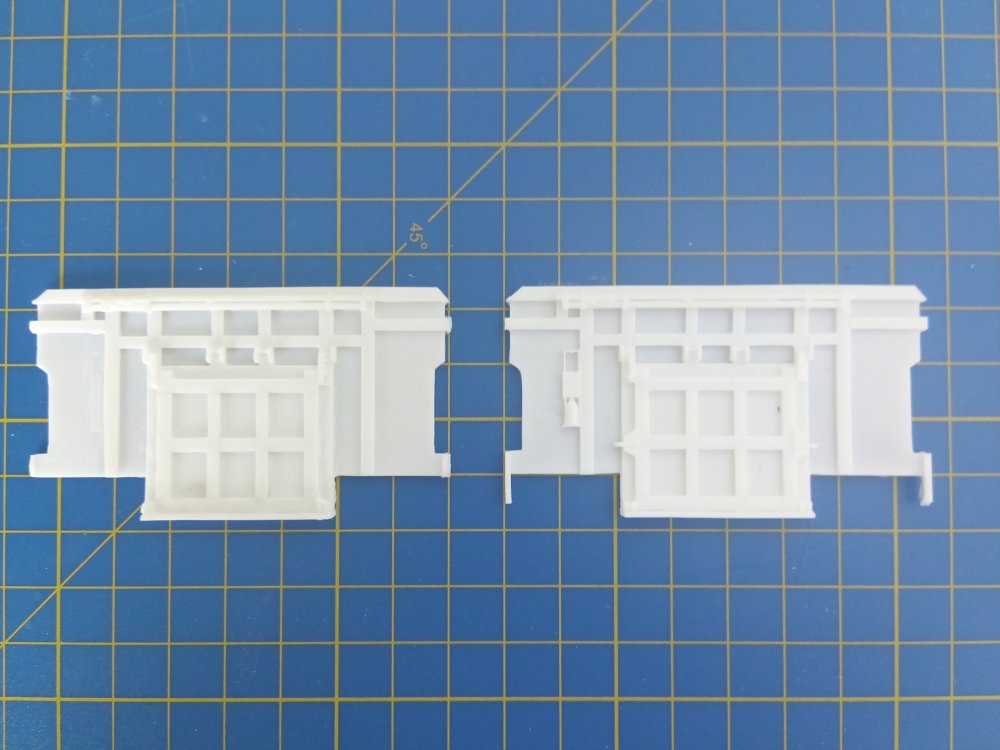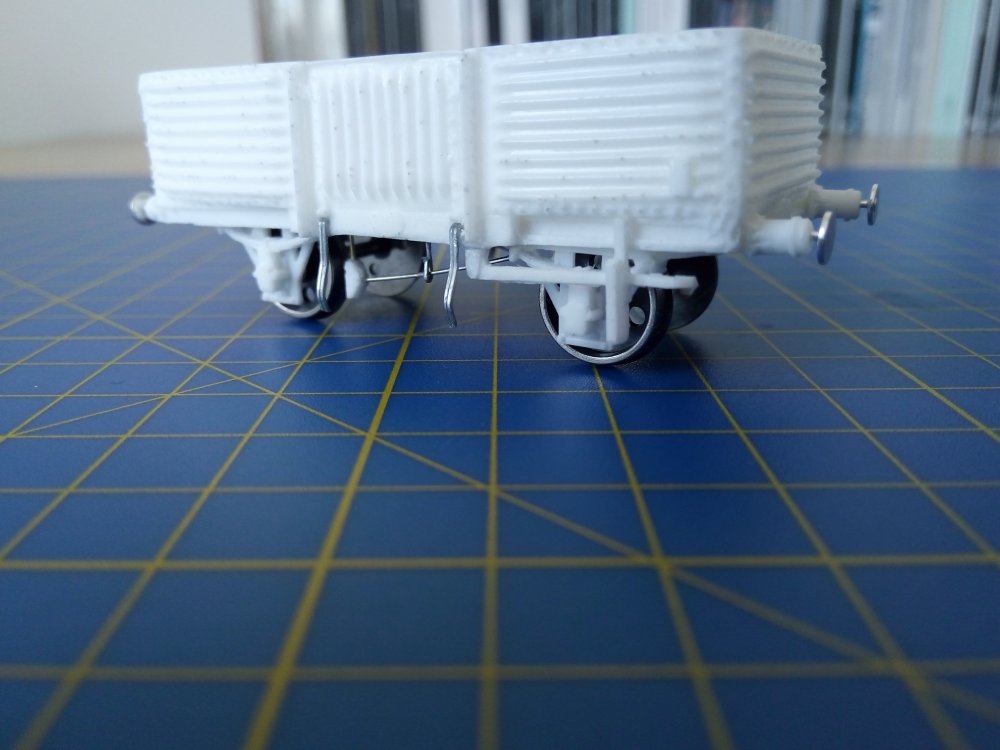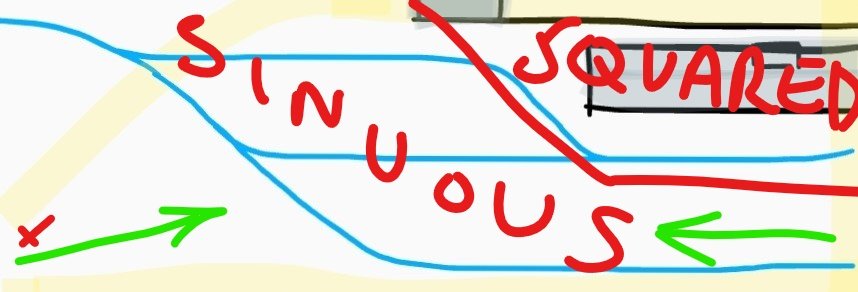
NIR
Members-
Posts
373 -
Joined
-
Last visited
Content Type
Profiles
Forums
Events
Gallery
Blogs
Community Map
Everything posted by NIR
-
This was on my commute, I was recognising buildings I have not seen for twenty years!
-
It's from the days of the Empire, a local word from the North-west Frontier area. Very apt! https://en.m.wikipedia.org/wiki/Sangar_(fortification)
- 91 replies
-
- 1
-

-
- 1975
- mixed livery
-
(and 8 more)
Tagged with:
-
Next build lined up, the MED parcels/luggage van. I will be using a Bachmann LMS 60 foot porthole coach as victim, not cheap but it's the right length and the bogies look good too. The MED trailers converted to these vans followed the MED lightweight build (steel body frames, ribbed sides, low roofline) around the time body and chassis were being integrated into a modern tubular construction so they look fairly distinctive. It's not just the low roofline, the lack of a solebar gives a distinctive see-through look underneath, with towards the centre what looks like a hanger for the side valances once sported by these vehicles. So I think this needs to start from the bottom up, remove the Bachmann trusses completely, remove the solebar below buffer centreline and represent the hanger with remnants of solebar and truss. Then with this as baseline offer up the etched body sides to see how much needs to be removed from the top. I can't see much in the way of underfloor equipment (battery box offside? regulator box nearside?) so will remove everything except for the brake cylinders, v hangers and brake connections then see what can be done with the pieces. I'm not sure what the two-tone paintwork is all about - differential weathering maybe? - but most of these photos are of the same vehicle anyway so I will probably not bother. I will try some scrap brass for the steps and will also model the handrails at the centre doors and the corners (though perhaps not the knobs) and maybe the lamp brackets too after plating over the ends with flat plastic sheet. I think the MEDs might have had smaller 3' wheelsets too so might have to change the Bachmann 14mm wheels for 12mm to get the full see-through look. As for the roof, I have ordered an aluminium BR Mark 1 profile and hope to flatten it somewhat with a rolling pin!
- 91 replies
-
- 1975
- mixed livery
-
(and 8 more)
Tagged with:
-
Manulla Junction at 2am must have been some place during a storm! There is just too much to read in this thread...
-
Made a start on the spoil wagons. I am modelling them in their later PW configuration so (left hand side) have removed the ram that powered the door-lifting chain, the door lugs to which the chains were attached via the rotating bar at the top and the hangers for the footboards(?) on the solebar. I won't be modelling the handrails either, except for the remarkably persistent centre handrail, nor the cutoff half door/removed top lip variant as I think it diminishes the essential character of these implacable brutes I'm not at all sure how they operate in this configuration but, as far as I can make out, in their original configuration the ram pulled down on a chain attached to the outside of the top bar which caused it to rotate so that chains fitted further along on the inside of the bar raised the door above doorstops on each side until the load forced the bottom of the door open and was discharged. The handrails and footboards(?) were presumably used by two fellas who relocated the door behind its stops as it was lowered back down. With the houses that close this must be right next to the main line out of York Road station
- 91 replies
-
- 3
-

-

-
- 1975
- mixed livery
-
(and 8 more)
Tagged with:
-
Ernies Massive Irish 1930's to 2005 Photo Archive
NIR replied to Glenderg's topic in Photos & Videos of the Prototype
Lots going on in Waterford, three different flows! I always intended to go back and do Waterford - Limerick but it never happened. Never look back, like my childhood memory of passing a sparkling blue Lough Owel in a buffet car... -
Thanks, I have three ivory CIE cement bubbles on order to add some Derry line freight operation to the Larne line spoil wagon formation. Then onto an etched brass MED parcels van to raise the quirky NIR-ness quotient tenfold!
- 91 replies
-
- 1975
- mixed livery
-
(and 8 more)
Tagged with:
-
My first kitbuild. It's a wide-angle photo, the buffers are not that wonky Not prototypical but I needed a fairly easy kit to start with, though I'm sure I saw one or two knocking about NIR in the 80s. Next up three NIR spoil wagons, with the open wagon above that should make for a decent PW train. Happy Easter!
- 91 replies
-
- 2
-

-
- 1975
- mixed livery
-
(and 8 more)
Tagged with:
-
David, not sure if this is relevant but I had a look at Halfords colours and noticed that some specified use of their red primer not their grey one, I think Rover damask red was one of these.
-
Interesting signals!
-
CIE cement wagon shows Irish Cement photo https://irishrailwaymodels.com/collections/cement-bubbles/products/cie-cement-wagon-multi-pack-h Irish Cement wagon shows CIE cement photo https://irishrailwaymodels.com/collections/cement-bubbles/products/irish-cement-wagon-multi-pack-g
-
I think you have the descriptions and photos mixed up on your website so it is unclear what you are actually ordering
-
Yes, if you want to model the usual run of homes and distants you can just drop them in somewhere far away from everything else, maybe a distant before a level crossing assumed somewhere offscene.
-
So in a nutshell, in a model you need to signal the routes not signal the flows. Signalling of flows (the blocks, homes and distants stuff) can be mimicked by having proper separation between trains on the layout - by not having them run on each others tails, by not running them right up to a conflicting route simultaneously and by using the late clearance of stop signals to check their speed before negotiating points.
-
Larne Harbour, the inspiration for my track plan. Maybe changed a little between the 60s and the 80s but it seems I have a fairly good memory!
- 91 replies
-
- 1
-

-
- 1975
- mixed livery
-
(and 8 more)
Tagged with:
-
I'm just seeing if it reduces to some rules of thumb for trackplan and use, coming up with some generic situations like 'diverging route', 'terminus', 'sidings/loop' instead of talking technical terms like 'home' and 'distant' which seem fairly irrelevant. In your examples a busy passenger station is 1 and 2 in my terms, needing lots of splitters and starters, and a goods yard is 3, potentially needing just one ground signal on the final exit.
-
Signalling discussions often get bogged down in talk of blocks, bell codes, homes and distants as if actually operating ten miles of busy mainline. So, keeping it relevant, what is the minimum signalling required for a layout to be prototypical? Is it as simple as 1. stop signal to indicate diverging routes ahead (can be assumed offscene, if not too far back from the diverging routes) 2. stop signal to start a movement from a terminus/onto a converging route/onto a single line 3. stop ground signal on final exit from sidings/goods loop 4. stop ground signal each direction on a trailing crossover 5. no signals on simple continuing lines (not modelled for long enough for blocks, homes, distants, etc to become relevant) (everything else can be reduced to the seven elements in bold - a facing crossover is a diverging route, a diamond crossing is a diverging route and crossover, more complex goods yards are two or more sidings/goods loop, level crossings are continuing lines) So a through station with routes diverging then converging again and a single fan of sidings could require just starters and one ground signal operated from a signal cabin nearby. Or a through station with continuing lines, a single fan of sidings and a trailing crossover could require just three ground signals operated from a nearby ground frame. Simplest of all a through station with just continuing lines requires no signals at all, though if you model a signal cabin there does need to be a stop signal somewhere nearby as a nod to the homes and distants nonsense.
-
Let's not forget the typical Ulsterbus, engine as noisy as a 70 Class. The armoured RUC land rovers needed two armoured British Army landrovers as escort where we were going, then you crossed the border and everything was back to normal. It all left a big impression on a visitor. Looked at foam board and mounting board in my local Hobbycraft today, looks just the thing for structures and surfaces
- 91 replies
-
- 1
-

-
- 1975
- mixed livery
-
(and 8 more)
Tagged with:
-
Haha, not sure I would want to do that although it was *very* noticeable. RHC, UYM and YCV were a bit of a mystery to me but I remember UVF being changed into LOVE with an L and a couple of _ The NCC was very much 'the long way around' for us. I imagine 'Ballyshane' has a flute band.
- 91 replies
-
- 2
-

-

-
- 1975
- mixed livery
-
(and 8 more)
Tagged with:
-
BR Class 105 (and Class 110) roof extractors were supplied by Greenwood's & Airvac Ventilating Co Ltd https://www.railcar.co.uk/type/class-105/description Presumably also supplier to the UTA/NIR builds. I'm pretty sure I saw the same vents on lorries, vans and buses too.
-
That is the one area of British outline I would consider modelling, a quiet Southern branchline terminus or Colonel Stephens light railway
-
Still in the rolling stock procurement phase so no civil engineering, but here is a visual concept. X marks the vanishing point on the backscene. Hills and sea meet low down in the far distance as viewed from the right, viewed from the left the backscene is oblique to the viewer so there are no odd perspectives to hide, the backscene coming forward has done that job. Moving right the vanishing point comes into view then zooms out, the distant featureless hillside working like a fractal at each scale, meeting a sinuous zone suggesting ground contours engineered along, trains emerging into the foreground with a pleasant sway. Then a squared zone, corrugated RUC station with concrete sangar to the left and terraced house backs to the right, maybe set on a slight oblique so as to present more corner to the left. An opportunity to confine a different vanishing point, a watery grey town skyline, within the alley between the house backs and the RUC station. Maybe the suggestion of a road emerging obliquely uphill from behind the corner onto the break between a rising foreground and a backscene of rising hills, just a line of real/painted lamp posts on the break, taking the precast concrete bridge over the hole in the backscene then sweeping towards the vanishing point. Fields of fire from the sangar to follow...
- 91 replies
-
- 1
-

-
- 1975
- mixed livery
-
(and 8 more)
Tagged with:
-
Answering my own question, still no idea what they are called but they look to have been hexagonal (pointing front/back and slightly elongated) not square http://www.easybuildcoaches.co.uk/TOP/DOWNLOAD/Cravens Class 105 v2.pdf (page 16) and as model castings they seem to have been made by Craftsman Models of Warwick, who no longer exist So not monsoon vents
-
Same as on a BR Class 105, but not looking much like the monsoon vent casting, so what the hell are they?
-
Those low profile, square roof vents that seem to appear on lots of northern railcars and coaching stock Are they monsoon vents? - nothing else from the model suppliers comes close but it's difficult to find a decent photo of the buggers https://www.wizardmodels.ltd/shop/carriage/roof-castings-set-24-monsoon-vents-rc8/
.png.c363cdf5c3fb7955cd92a55eb6dbbae0.png)



